
Let it be known that I am sarcastic, opinionated, and admittedly more subjective than objective. So you should take my notes about the Viking River Cruise (life aboard the ship) for what they are worth…the opinions of a 40 something New Yorker that has a bit of travel experience and (probably unrealistic) high standards for everything that I see and do. I’m very honest, but I also have a sense of humor and I’m open-minded. So, with that out-of-the-way, we are about 7 days into the river cruise, and there are a few observations about the cruise that I can make here at the half-way point.

Overall, the Viking River cruise is a cool way of seeing Europe. We can literally lay in our bed and watch hundreds of years of history slowly pass by us with the river just a few feet below us. We are also afforded very unique perspectives of these towns and cities that we sail by….viewing a town from the middle of the river is obviously not something that you could experience traveling by car, train or on foot.
The food has been good (but not stellar), and surprisingly, the portions that they serve are very modest…maybe 4 oz. of steak/fish/chicken for a main course. And when you are eating 3 full meals a day, which is not something we would be doing back in NYC, the smaller portions are appreciated. The housekeeping of our room has been excellent and our caretaker stocks our mini refrigerator with Pelligrino and white wine on a daily basis, just as we like it. Our room is always impeccably clean and comfortable. And we have met some really interesting people from all over America, from England and Australia. Everyone seems to have an interesting past (as most are now retired) so mealtime chats are never boring.

But on the flip side, on day 7, there are some realities of river cruising that are a little annoying, surprising and/or disappointing. I’ve complained about the endless river locks in a previous post. They are a necessary evil of traveling this cruise route. But here are few things on my “what I don’t like” list:
- Dining Monotony. Eating 2 or 3 meals a day in the same dining room gets old really fast. Sure, you can eat on the Aquavit Terrace, but it’s the same general environment, same menu and food and the same servers. We miss eating in quaint little restaurants or cafes where each meal is a different experience. Sometimes, you don’t want to sit down at breakfast and have a full on conversation with strangers….you just want a nice, quiet moment to sip your cappuccino and time to think. Lastly, there is no real option to eat in your room. There is no room service, even for our top-notch suite. Sure, in the morning, you can bring a coffee and pastry back to your room and eat on the deck, but there are no such options for lunch or dinner.

- Cattle Herding Syndrome. Compared to an ocean cruise where there could be 2000 or 3000 other travelers, a river cruise is small with only 180 passengers. But even with that smaller number, you feel like part of a herd most of the time. I’ve spoken about the 7:00 hour when all 180 passengers make a mad dash to the dining room to get a good table. Or on excursions, even before leaving the ship, everyone is packed in the small lobby area, incredibly anxious to get off the ship. And then like a herd of cattle, we file one by one off the ship, up a ramp, and single file into a tour bus. And then after reaching our destination, we are herded around these little towns with no sense of exploration. I suppose I am realizing that I’m a loner at heart and just want to do my own thing when I want to do it. I think I had imagined the ship being docked a lot more often…and having the opportunity to wake up and get off the ship before any tours or excursions started. Thus far, we haven’t had that opportunity.

- Constant Clock Watching. I’m on vacation! I want to sight see and eat great food…but at my own pace. On a river cruise, you are on someone else’s schedule. You are constantly looking at your watch. Breakfast is only served from 7:30 to 10, Dinner is promptly at 7PM, excursion departure is at 8:30AM, bus will be leaving at 5PM, one hour of free time before you must be back on the bus, etc.! In previous trips to Europe, I don’t think we ever even look at our watch (unless we have specific timed tickets). Sure, we have a loose itinerary of what we want to do that day, but it’s all at our own pace. We eat when we are hungry, we spend as long as we want in a museum, we stop for a coffee or a glass of wine in the afternoon, and we stay out as long as we are having fun. If you like regimented travel, a river cruise will be great. If not, you may feel like daily life is way too structured.


We sailed all morning and arrived in Bamberg after lunch. Although we didn’t know much about Bamberg, we knew that after being on the ship all morning, we (or at least I) needed some free time from the cruise. We decided to skip the included tour (with a tour guide) and explore the town on our own.
The buses dropped us near the River Regnitz, which bisects the town, so we followed it into the heart of the old town and decided to climb our way up the steep sidewalks to the Cathedral, which is typically the heart of these towns.

The Cathedral’s origins go back over a thousand years to the time of King Heinrich II, who had been Duke of Bavaria and would go on to be the Holy Roman Emperor. It was Heinrich who favored Bamberg and decided to establish a diocese there. He had the first church built there in 1002, which burned down, as did the replacement which burned in 1111. The Cathedral that we visited today was built by three German princes and completed in the early 13th century.


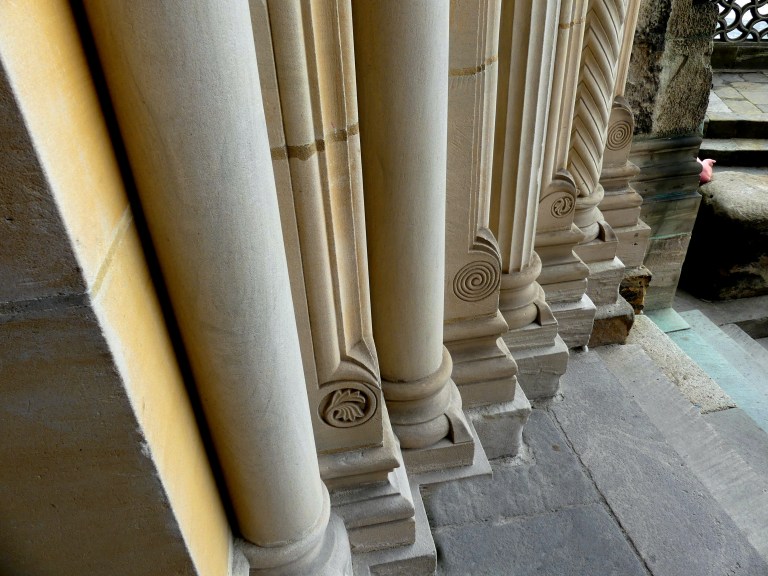



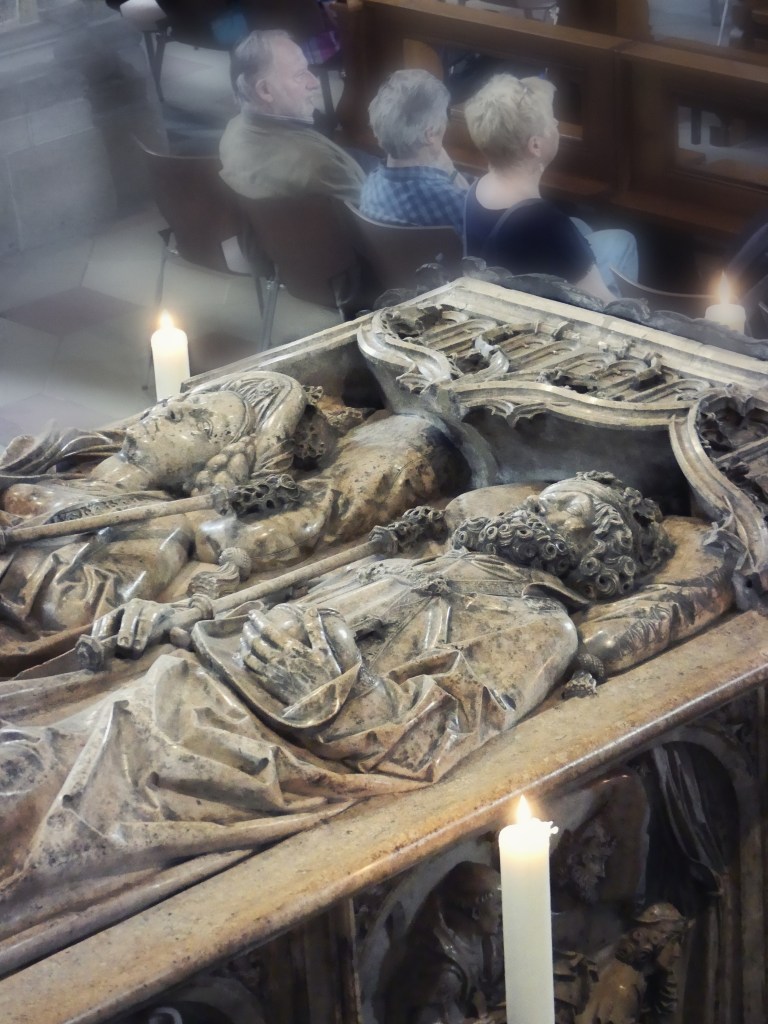

It’s a beautiful church, for sure, but besides the royal tomb and the Horseman statue, it’s not terribly large and there isn’t a lot to see inside….honestly, I found the exterior of the church to be far more interesting.

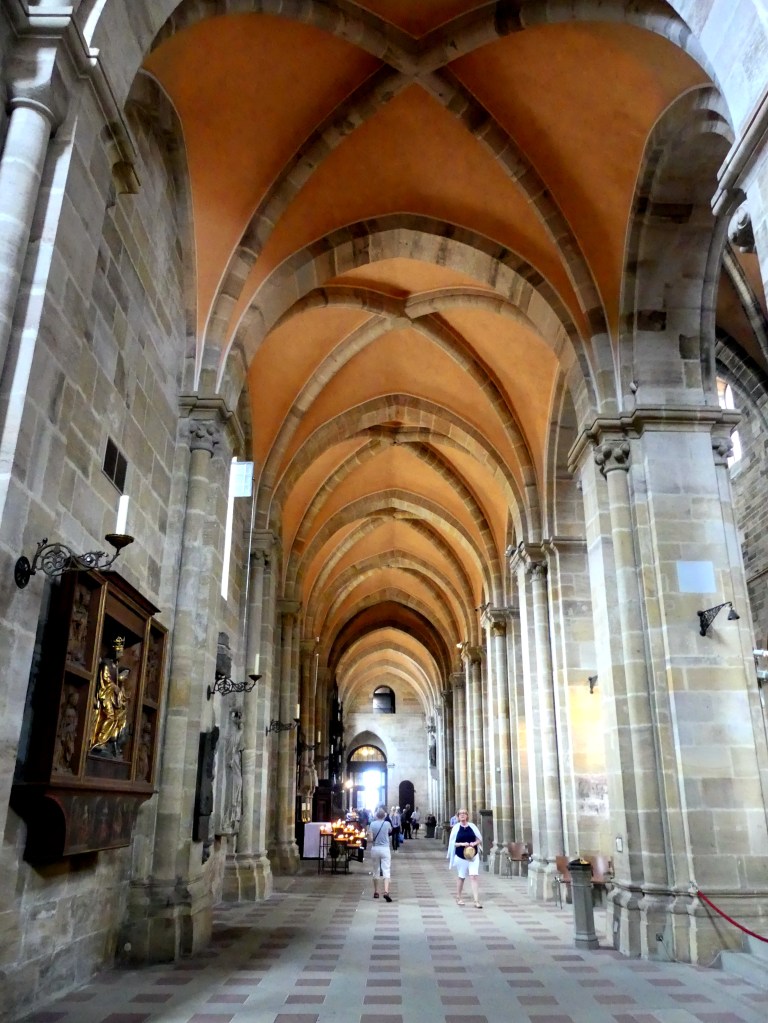
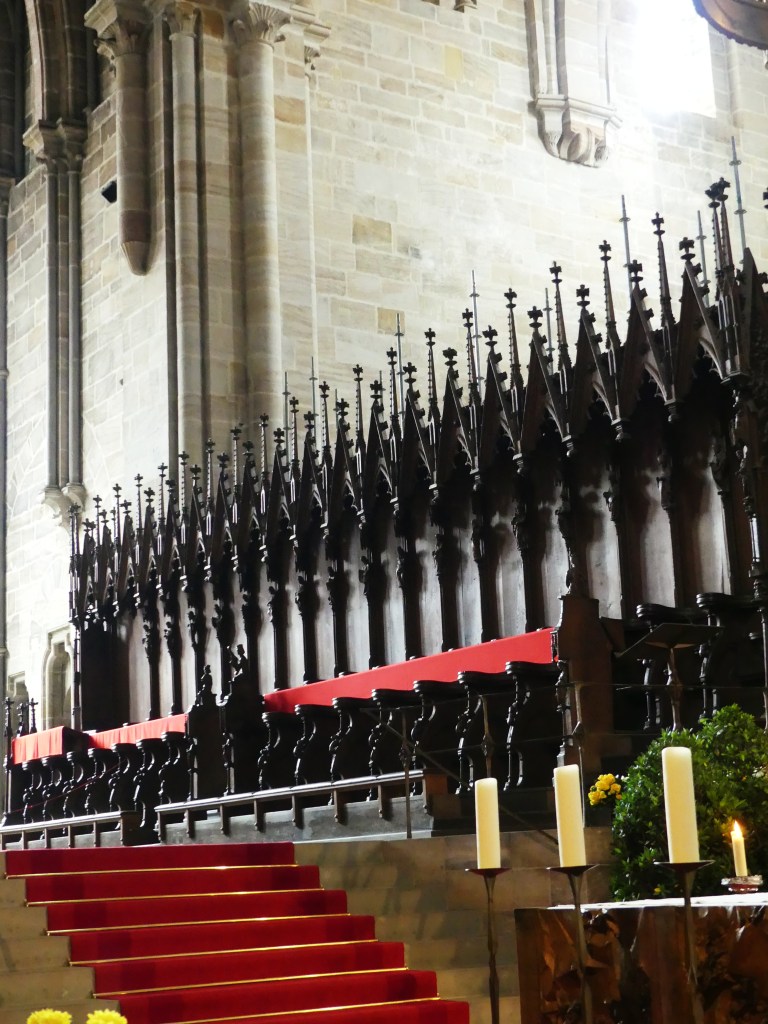
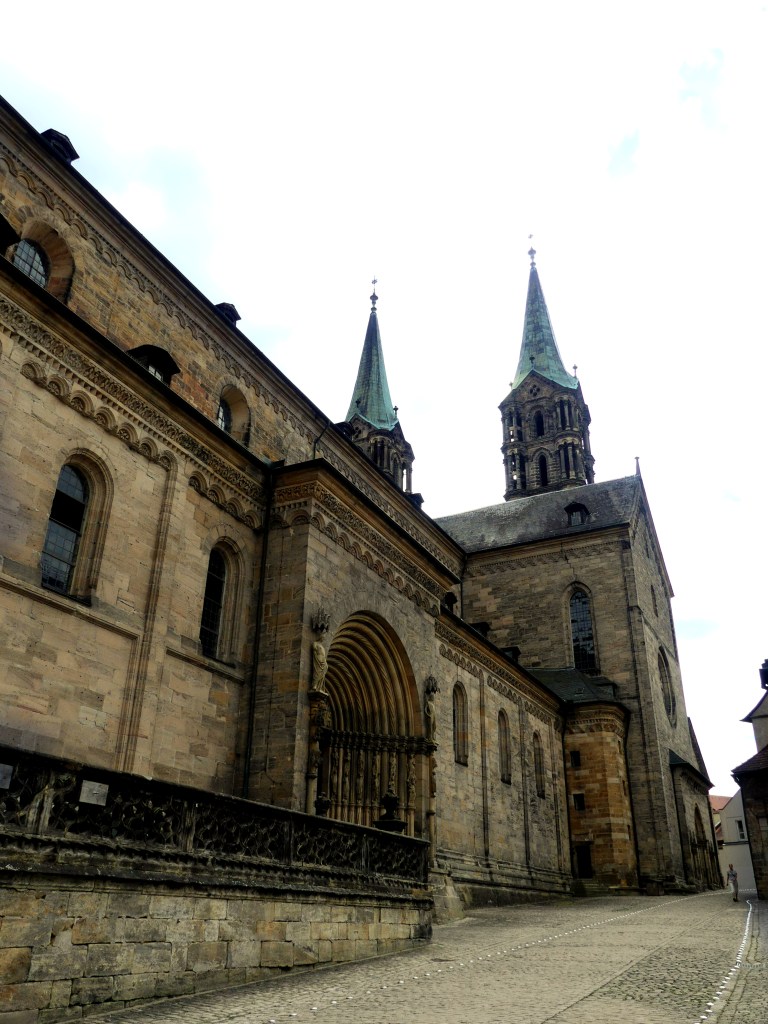

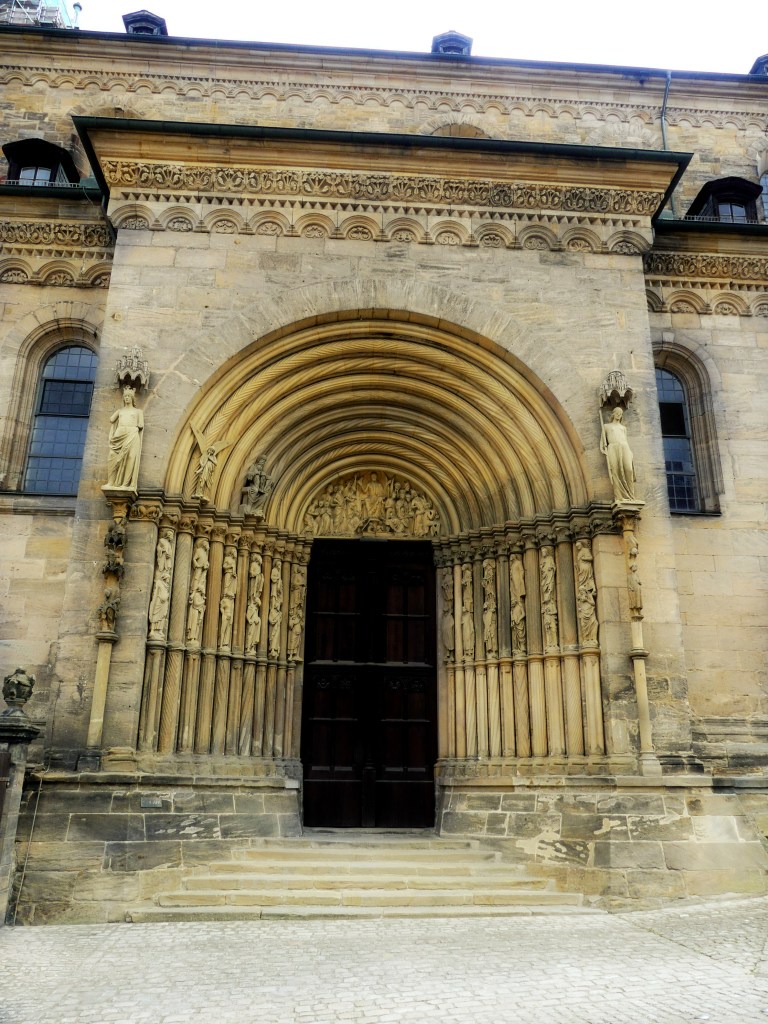
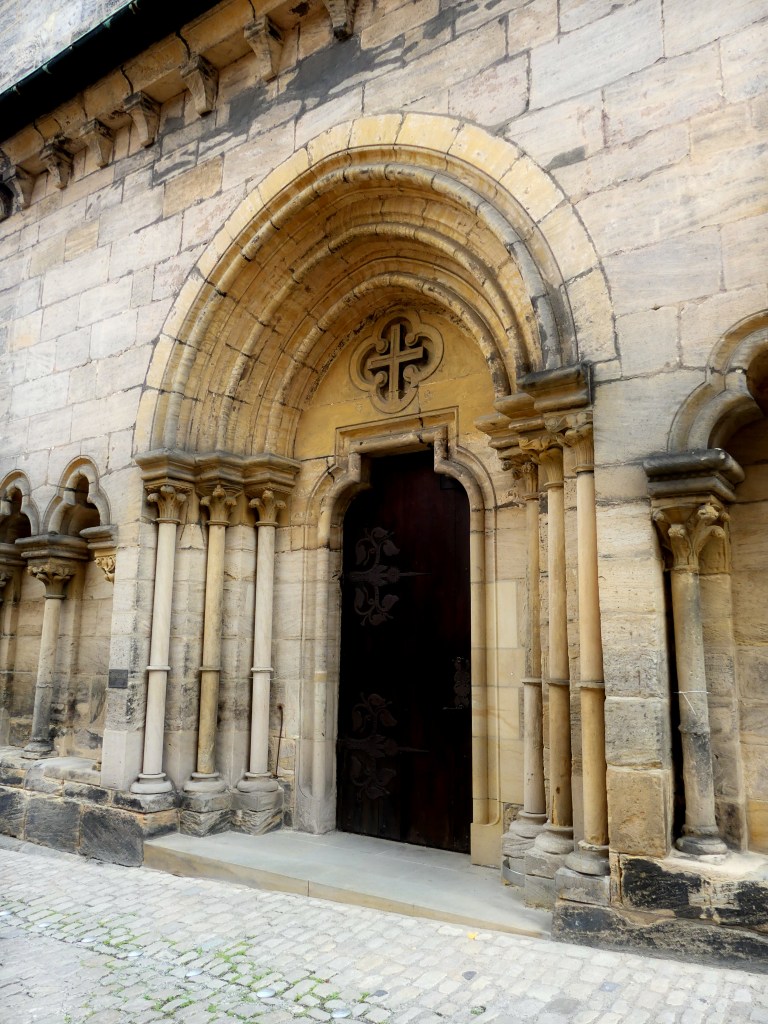
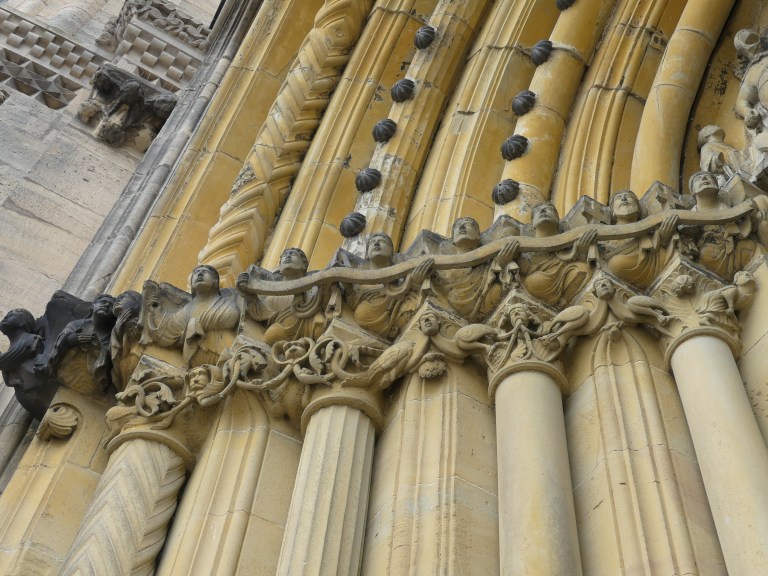

Just outside the Cathedral is a large, open square, and flanking one corner is the “L” shaped Neue Residenz, built in 1695-1704 as the home of the Prince Bishop of Bamberg. You will recall the very grand Würzburg Residenz that we visited yesterday with its frescoed ceilings and grandiosity….well, this Residenz was designed by the same architect and has similar, over-the-top ostentatious interiors. Since we had just seen something similar the day before, we chose to skip a tour, but from what I have seen and read on line, it would be worth a visit if you have not seen a Prince Bishop’s Residenz. They knew how to live large.

And flanking the other direction of the Cathedral Square is the Alte Hofhaltung (Old Court Hall) from the 14th century. Originally the Bishop’s Palace, the building now houses a museum (which we skipped). And in the photo, at the bottom right where all of the people are grouped, is a stone gate that leads to an inner courtyard. Named the Prachtportal (Magnificent Portal), this 15th century gate has images of the Virgin Mary in the center, along with Saints Peter, George, and King Heinrich against a backdrop of the Main and Regnitz rivers.
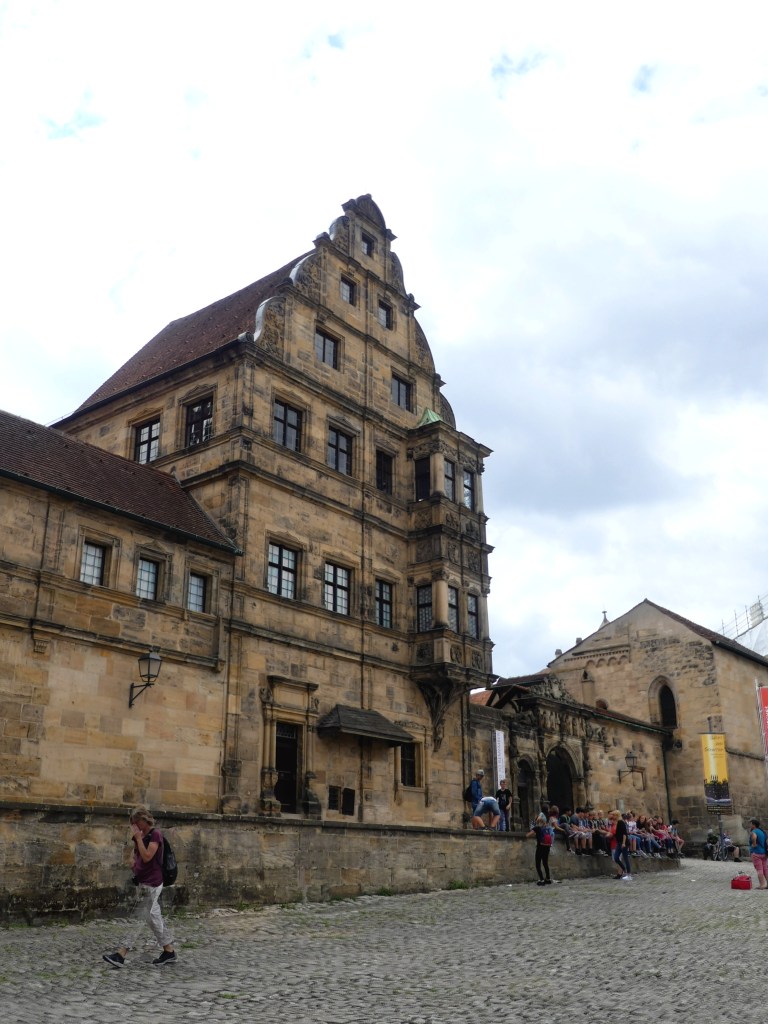
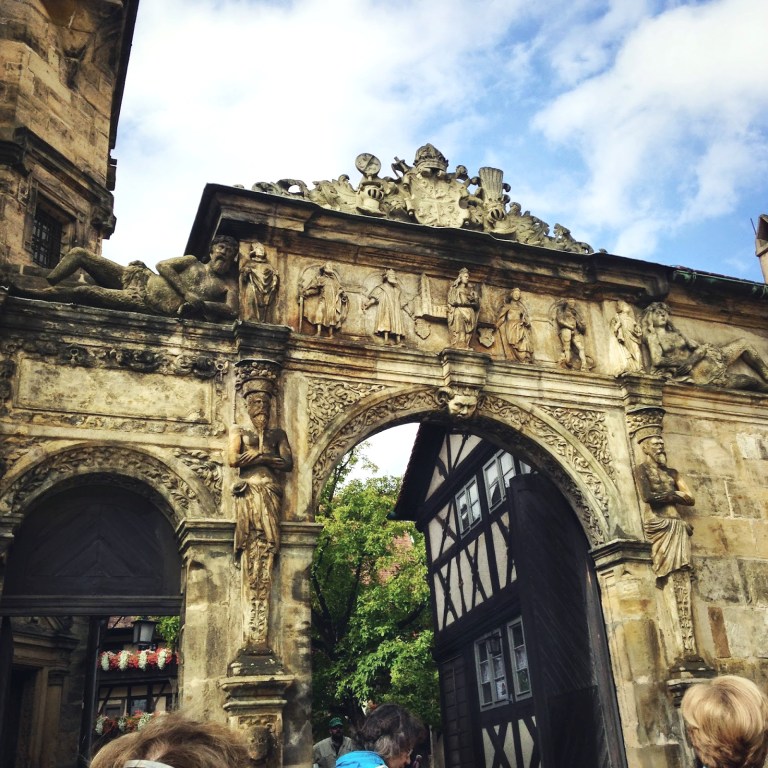
Once you’ve passed through the gate you come to another courtyard encircled by half-timbered, late gothic structures with flower-lined galleries. Apparently, there are often outdoor concerts and markets held in this space. Inside the courtyard, with the Cathedral as the backdrop, it is quintessential “ye olde Germany”….you are just waiting for a Disney princess to come walking into the courtyard with a basket full of laundry, singing some uplifting song as little blue birds flying around her head. Yes, it’s that picturesque.
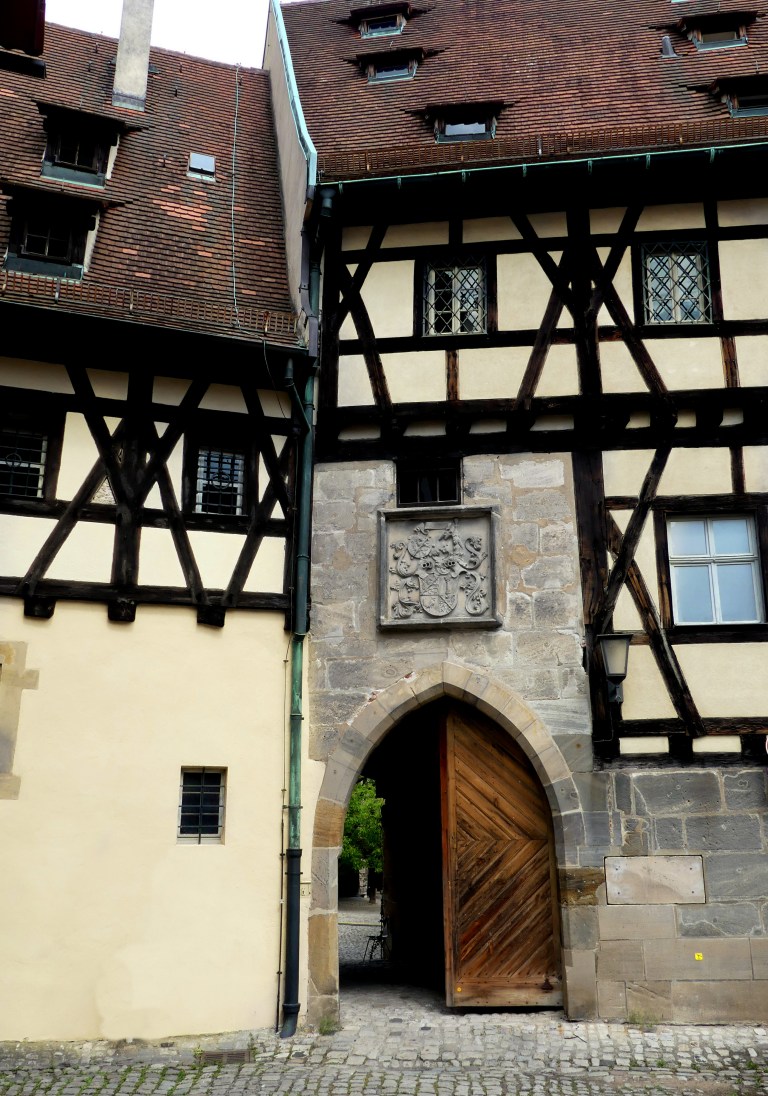


Before continuing our tour of Bamberg, I wanted share what I think is a very interesting blip on Bamberg’s long history. Starting in 1626, there was a five-year period in which as many as 600 people were executed for practicing witchcraft and several hundred more tortured and punished for the same crime.
Touring Bamberg and reading the tour guides, I don’t recall any mention of witchcraft. I did hear about it and mentioned in a previous blog post about the fountain in Miltenberg where they burned witches….and there were similar outbreaks in Würzburg, but it was Bamberg that was the hot bed of supposed witchcraft.
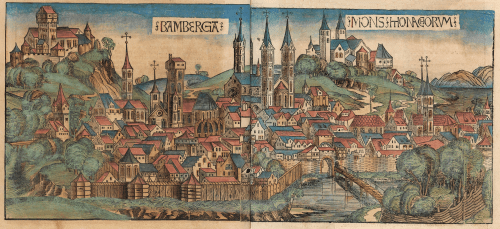
Note: Besides my Master’s in Architecture, I have a B.A. in American History, and I did my 4th year thesis on Salem’s town Minister during the Witch Trials of 1692. So, I may this may be a niche interest that isn’t for everyone….you can scroll down to the next section of the tour if that is the case. But this witchcraft business is interesting!
So, in 1626, Franconia and much of southern Germany was at a tipping point. There were plagues, famines, severe weather and crop failures, so everyone, rich & poor, was miserable. The Catholic Church was very unhappy because they were losing power, control and ultimately money due to the rise of Protestantism throughout Germany. Cities and towns, inspired by Martin Luther’s Reformation, were turning their backs and billfolds on the Catholic Church.
Accusations of witchcraft had been taking place for decades, but was not widespread. In the Dark Ages, as Romans (and Christianity) moved through the region, the German tribes slowly began to convert to Christianity, but they also held onto their pagan beliefs and still believed in magic, mystical places, herbal remedies and goddesses. To many Germans, witchcraft not a myth but a reality. Someone had to be responsible for the bad crops and terrible weather…something evil must have caused the plagues….it had to be that there were those in league with the Devil! The Catholic Church, and particular the Prince Bishops of Franconia, used these beliefs to their advantage. They could foster accusations of witchcraft and take out enemies of the Church and regain power and control over territories they had lost to Protestantism, as well as to seize property and assets of the accused.
In Bamberg, the witchcraft hysteria reached a peak under Prince Bishop Gottfried Johann Georg II Fuchs von Dornheim (say that name 3 times fast). He created a network of informants, and accusations of witchcraft were not made public and the accused had no legal rights. To top it off, Prince Bishop Dornheim built a prison to house the accused and hired a bevy of full-time torturers and executioners to punish the so-called witches.



The accused were routinely tortured with thumbscrews and vises, ice-cold baths and scalding lime baths. And besides being burned at the stake, they were whipped and beaten, drowned, put in iron-spiked stocks and had their bodies pulled apart on the rack. Most disturbingly, children as young as 6 months old were tortured and killed. And often, even after being condemned to death by fire, the victims would have their hands cut off as they were led to the stake. All of this might sound to dark to be true, but inside the Bamberg archive are the witchcraft documents (rescued by a historian in the 1830’s) which detail the trails, inquisitions, judgements and description of punishment of 884 citizens.

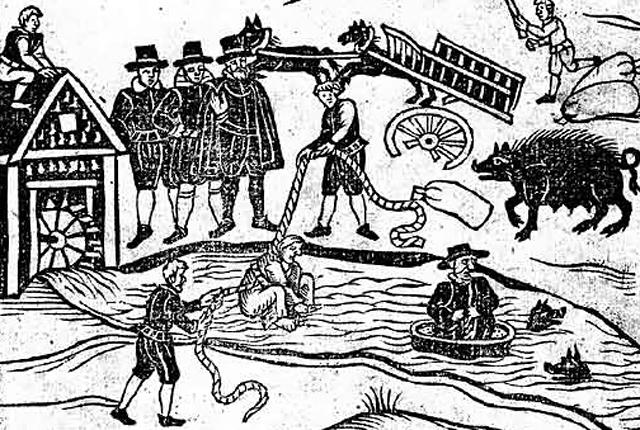

The frenzy of witchcraft came to an abrupt end when things hit too close to home, and the wealthy and powerful were also getting accused of witchcraft–their land and money was confiscated and that’s when the line had been crossed (not the torture of babies, I suppose). The Holy Roman Emperor Ferdinand realized that chaos had ensued and the situation was tanking the already poor economy. In the end, money is always at the core….and a decree was made in 1631 to end the persecution of witches as troops were brought in to regain order and prisoners were freed. And in 1632, the evil Prince Bishop Dornheim who oversaw this nightmare, died ending a bloody and charred era in Bamberg’s history.
A Walk Up to the St. Michael’s Monastery (Michaelsberg Abbey)
Next up, we decided to walk up one of Bamberg’s 7 hills to St. Michael’s, an old Benedictine monastery whose church is from the 12th century and other structures from the Baroque era circa 1700. The photo below is what we saw on the map that we got from our Viking ship’s concierge. We’ve visited several abbeys and the view of Bamberg was supposed to be sweeping and lovely. So off we were…

It’s quite difficult to tell from the 3D Google map below, but our trip from the Cathedral up to the Abbey was all uphill. Especially, the last leg which was a very steep climb up a residential sidewalk. But it was a very nice walk, passing by a mix of baroque era buildings with half-timbered structures.
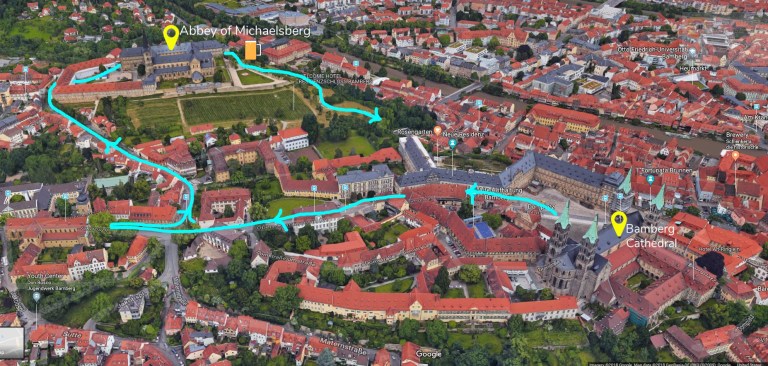
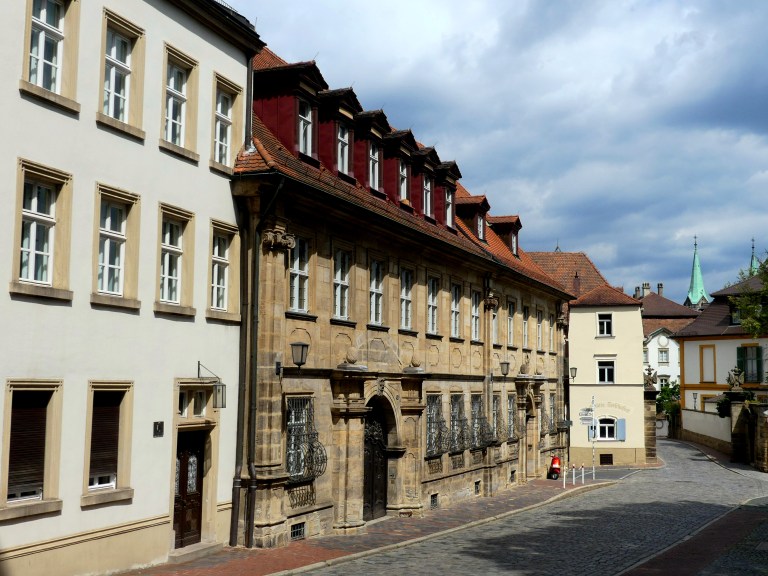
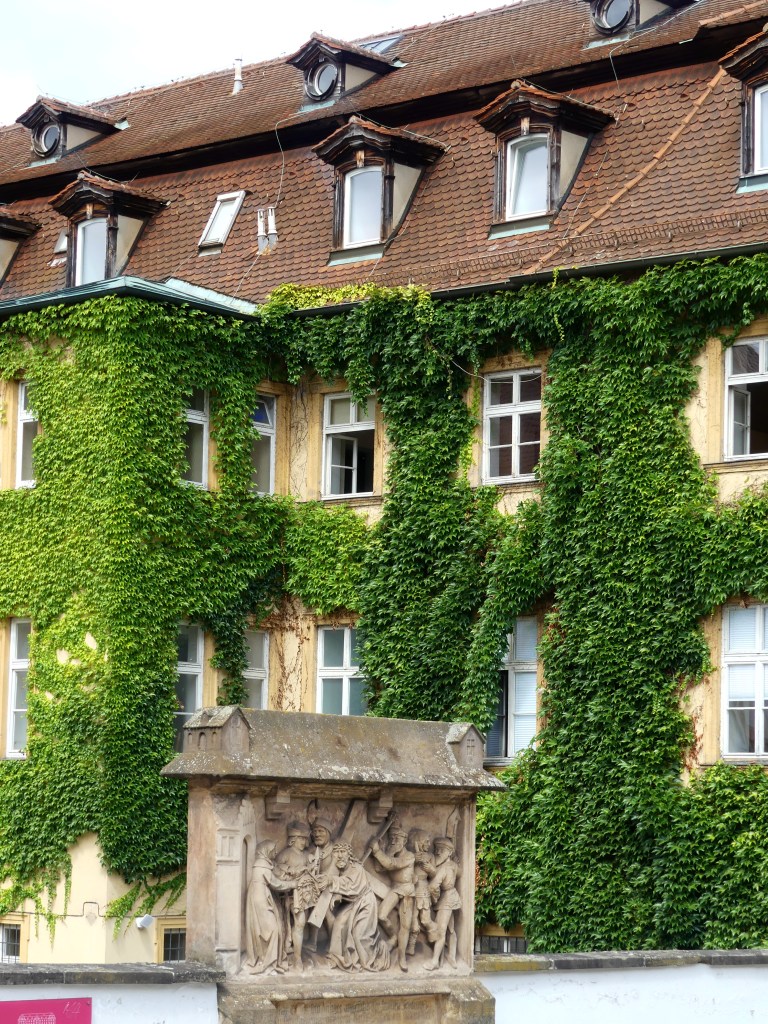
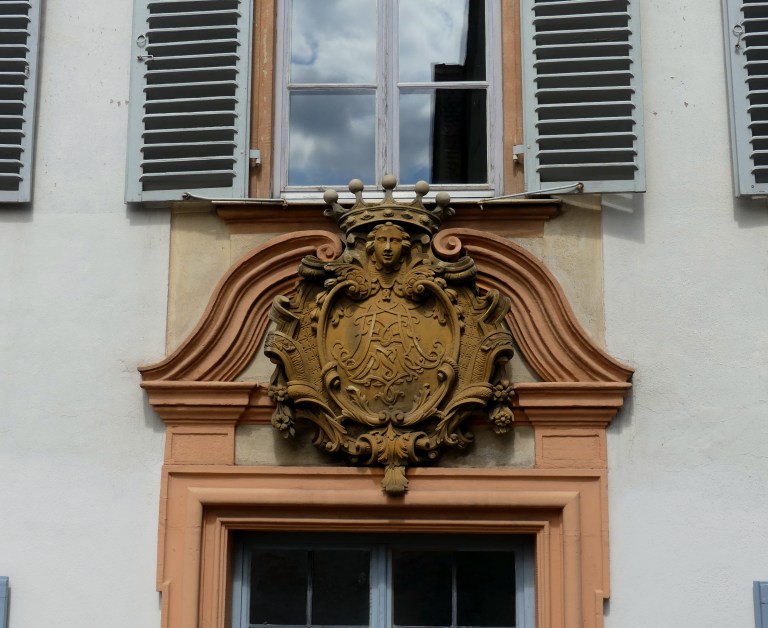




The last bit of the trek was pretty steep, but we knew we would be rewarded with a visit to this ancient abbey (and maybe even climb a tower, or two). But when we arrived at the top….we found a giant construction site. Everything was fenced in, wrapped up in scaffolding…and closed to visitors during the restoration. It was a major letdown. And yes, before deciding to climb up we did see the two towers of the Abbey in scaffolds, but this is quite common with cathedrals all over Europe. They are constantly being repaired and restored….but it rarely means that the interior is closed.
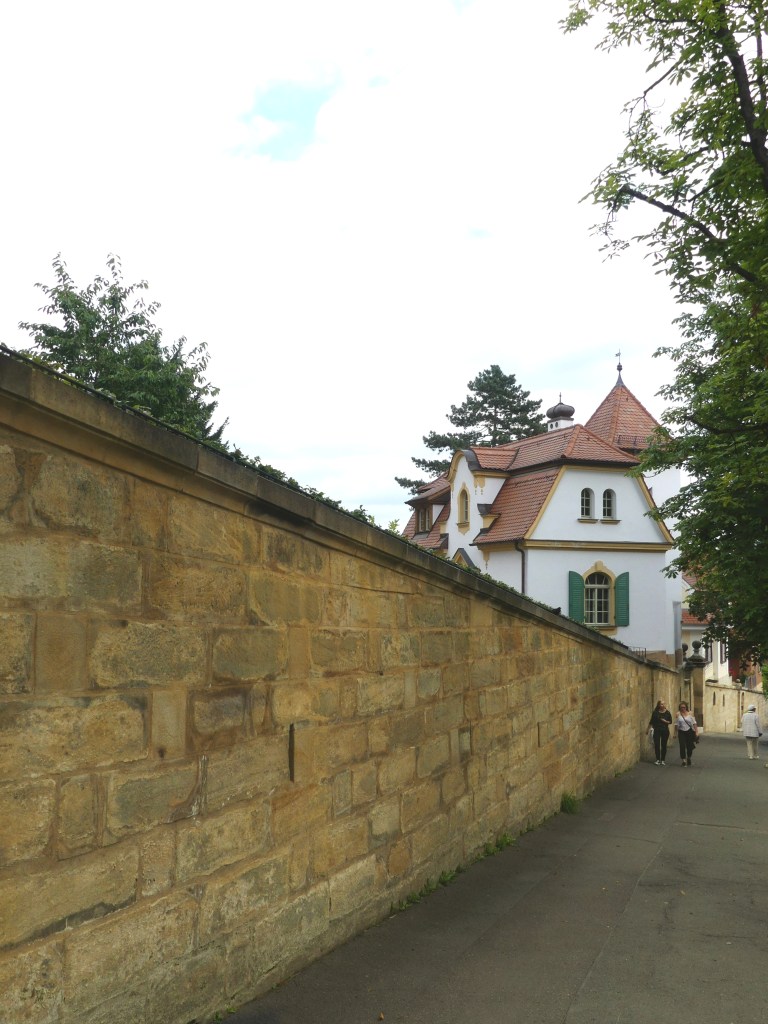

So, no visit to the Abbey for us. But the grounds were open, and there was a sign for a cafe, so we decided to take a break from the sun and the heat and relax our feet after the vertical trip up.

The cafe was cute. They had seating inside, but there was literally not a single soul there, and why would there be when they had outdoor seating overlooking the town and beautiful gardens behind the Abbey? The garden seating wasn’t very crowded either….maybe 3 other groups just sitting and drinking beer (and smoking unfortunately). The service was a little slow to acknowledge us, and the waitress wasn’t super friendly, but I’ve discussed the whole topic of service in Germany before…you just have to relax and go with the flow.

The menu was in German (see below) and if it weren’t for my translation app on my phone, I would have no idea what anything was expect for a few words…I knew one section was beer and the other section seemed to list cakes, etc. We figured this was the perfect opportunity to try one of the famous smoked beers that Bamberg is known for. We chose the Spezial Rauchbier…vom fass…or from the barrel (on tap) and Josette ordered a cake (torten) but I don’t recall which one….I think it had strawberry and lots of whipped cream.

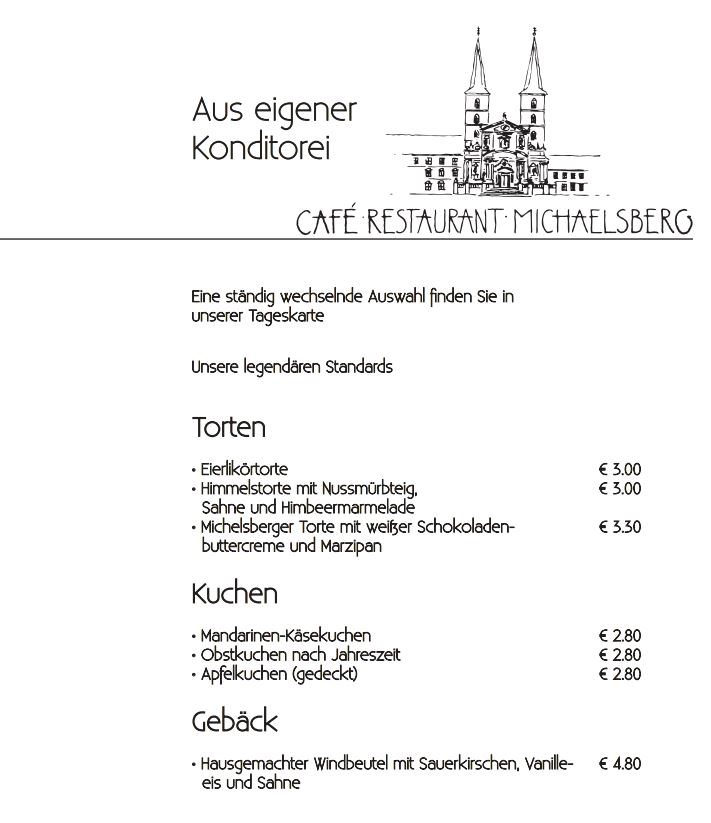
So….the beer….the Spezial Rauchbier (smoked beer) was interesting. It’s brewed in a local brewery right down the hill in the heart of Bamberg. As I’ve stated before, we are wine people, with the occasional margarita or a rare vodka with soda. We drink maybe a few bottles of beer per year at a cookout or at a pizza joint, but it’s always a lager… something light like Stella Artois or Peroni or Corona Light. This beer was a lot. I mean, way too beery (not to be confused with “berry”) for me. And it wasn’t hot….but it wasn’t even approaching cold. On a hot day like this, I didn’t want a warmish beer. Later on the ship, I looked up a beer rating website and one reviewer described the Spezial Rauchbier like this:
“Pours clear copper with a thin, foamy, off-white head; little lacing. Aroma of smoked ham & sausage, charcoal, sweet tobacco, wood, toast, salted peanut. It tastes medium malty sweet, quite smoky & meaty, hint of umami sausage & ham, a bit bready; light herbal bitter with sourish yeast in the back. Smoky finish, a bit grassy hoppy with lingering bread & yeast. Light to medium body, watery texture, lively carbonation.”
I can’t disagree with how this guy describes the beer….he seemed to like it, but smoked ham & sausage with sweet tobacco and salted peanut??? No thanks, I will stick with my Franconian white wine!

Continuing on, for the remainder of our afternoon, we wandered our way down from St. Michael’s, passed by the Cathedral once again, walked back through the old town and across the Obere Brücke bridge where the Altes Rathaus (Old Town Hall) sits in the middle of the river, and then across the river to the merchant/commercial side of town. There we stopped in a pharmacy, toured St. Martin’s Church, and wound our way through the Bamberg University area until we reached the Concert Hall where our buses were awaiting us (see bulls eye).

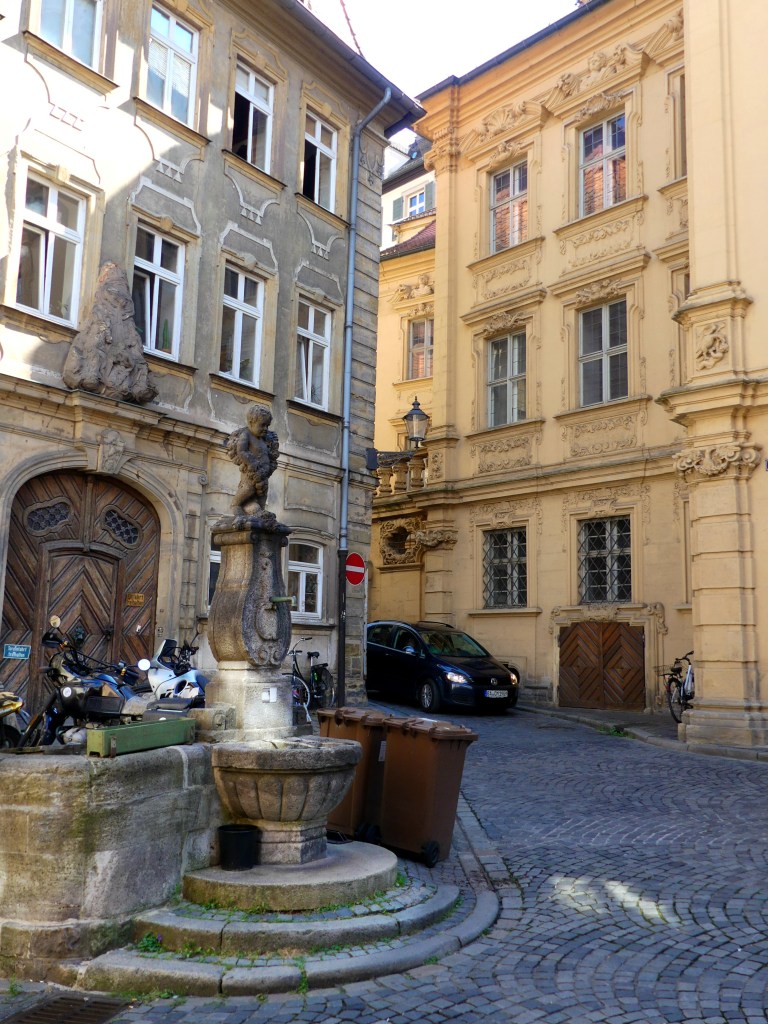
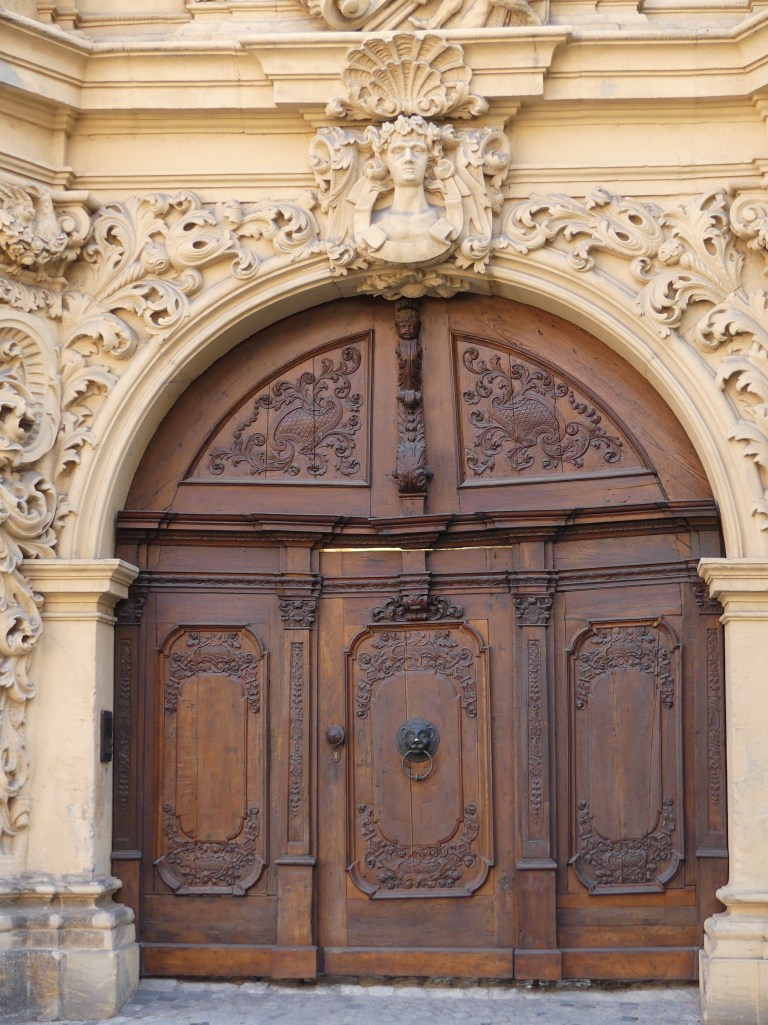

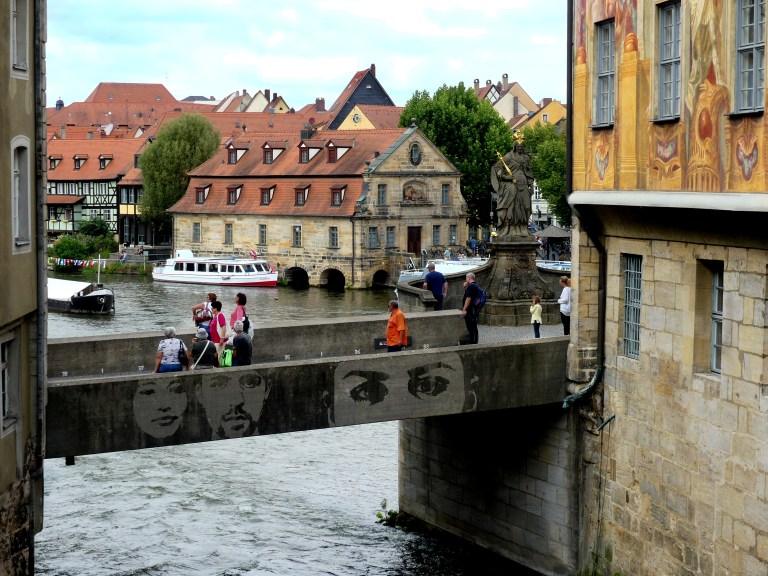
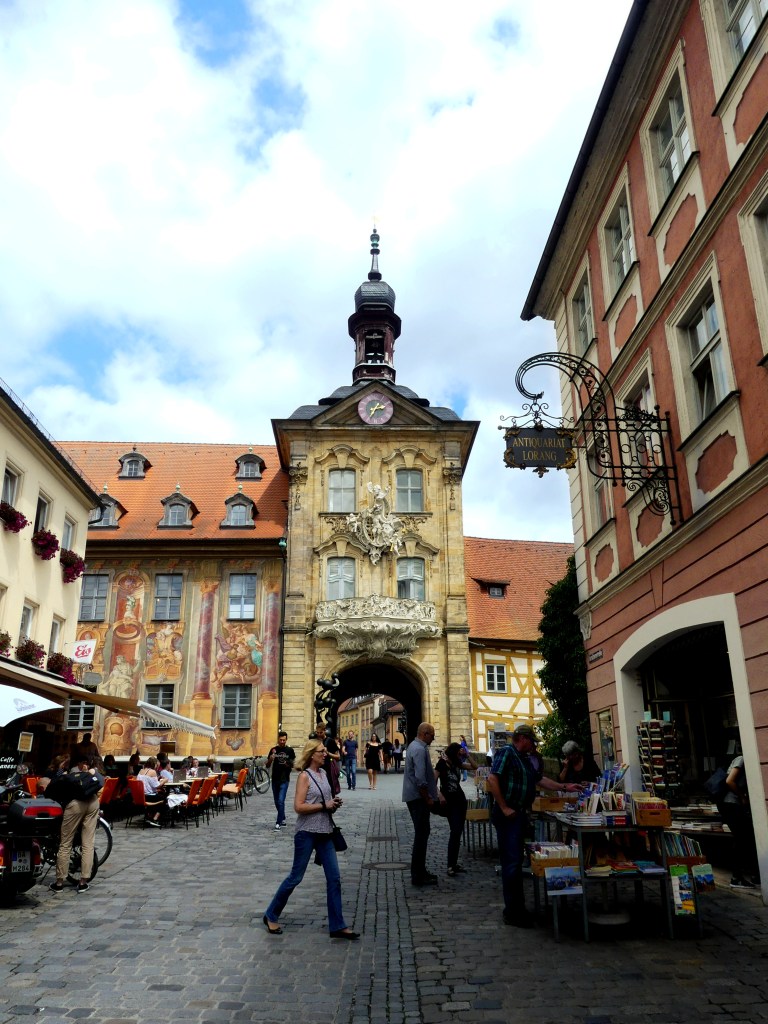
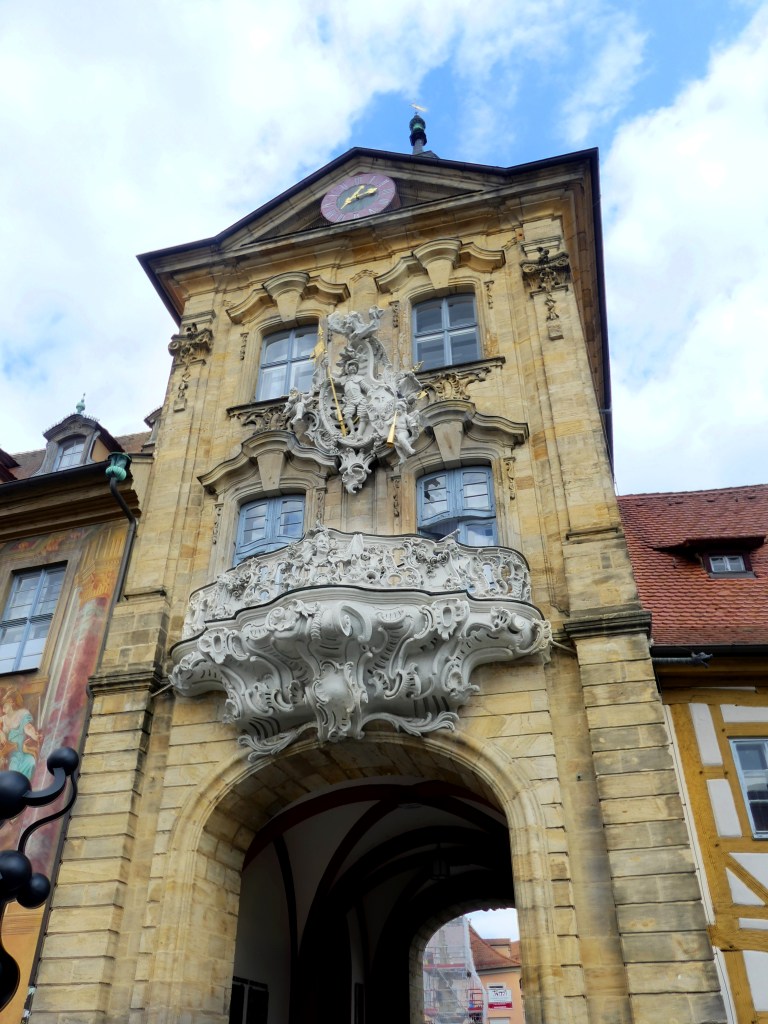

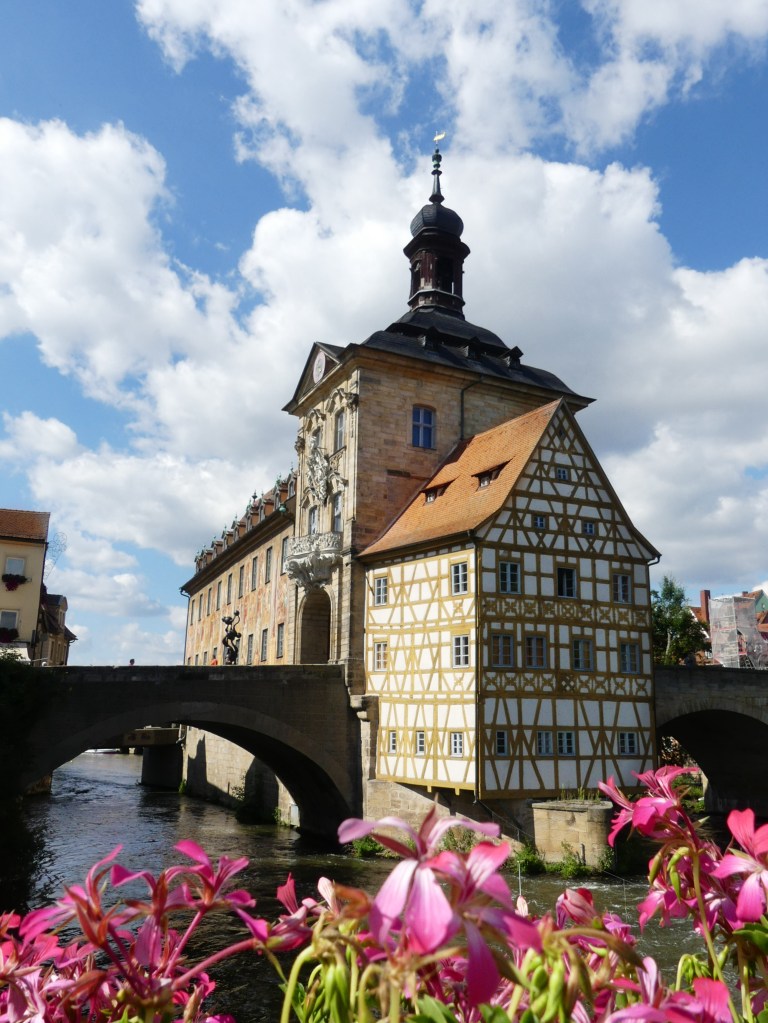
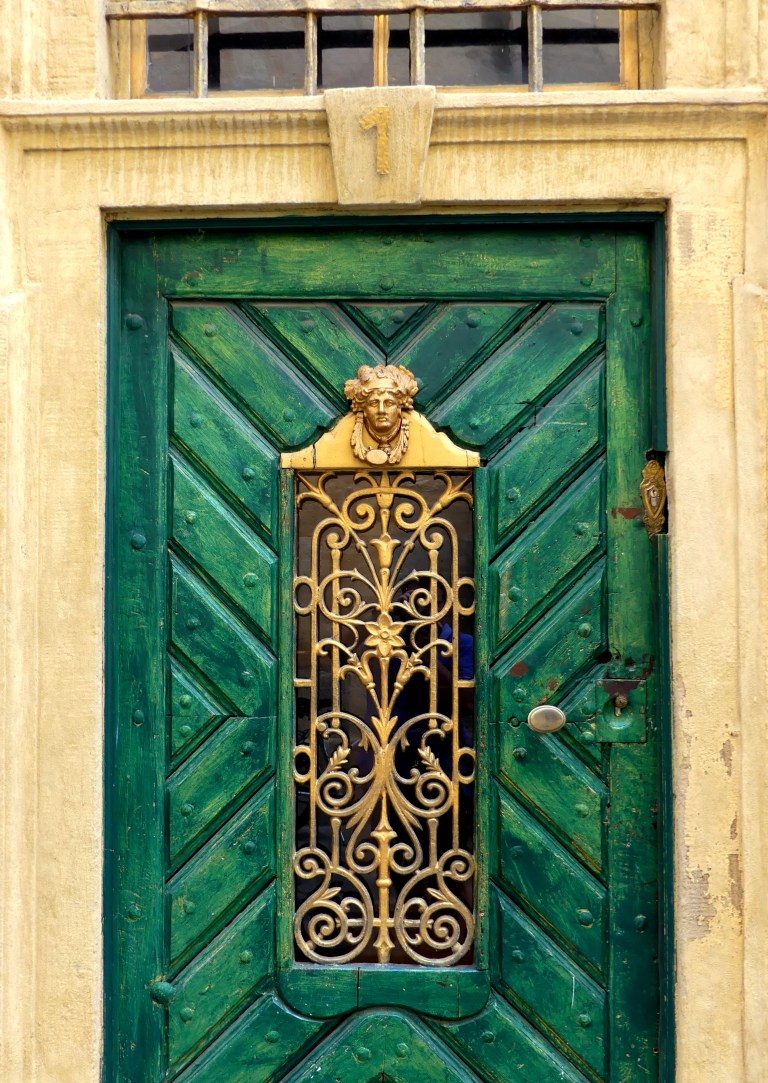
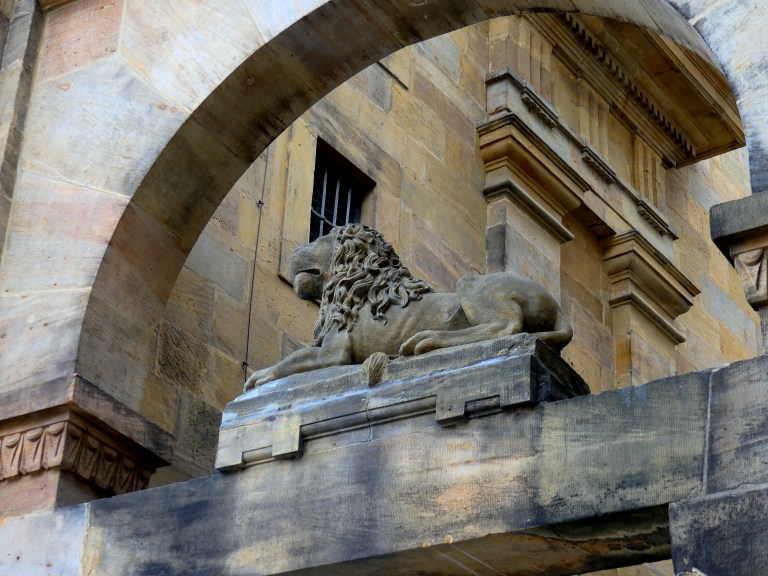



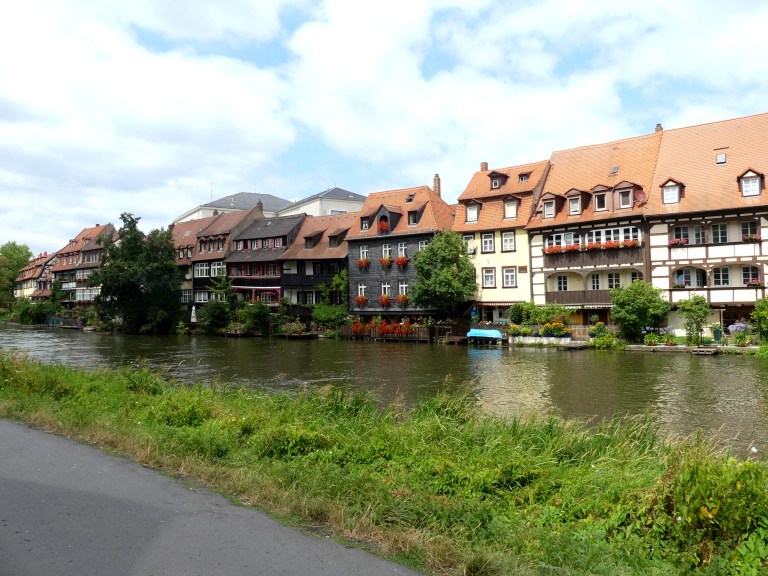

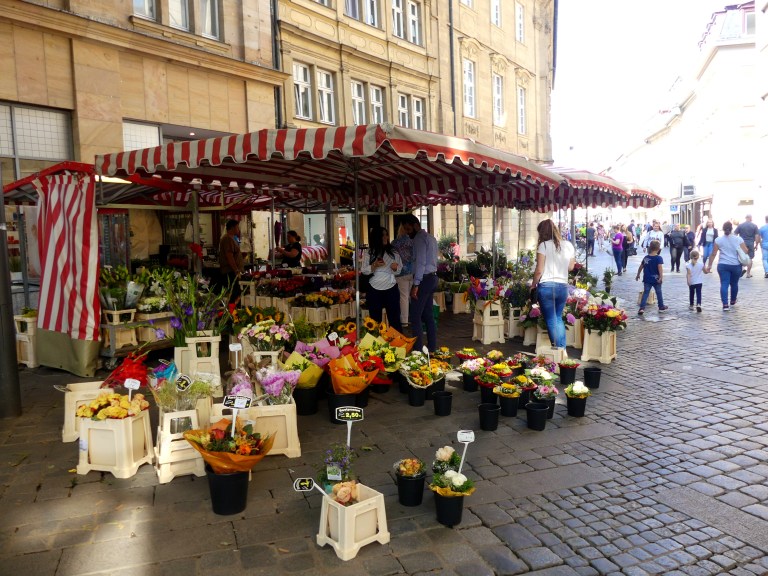
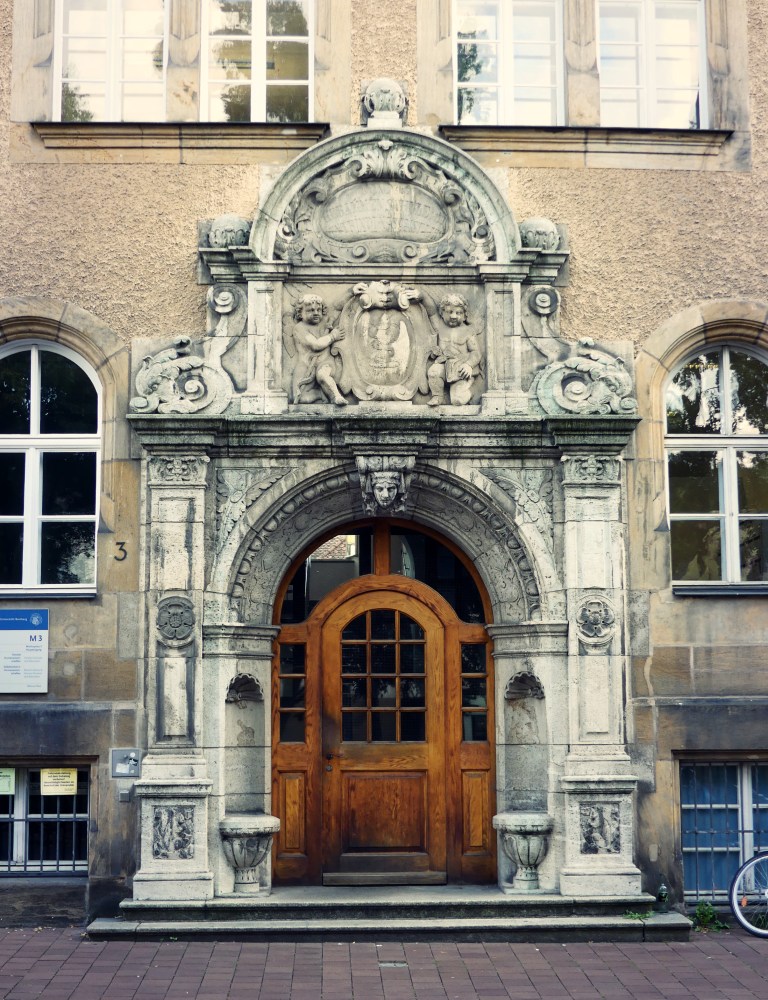
We got back on our buses and rode back to the ship where we all knew what awaited us. We were informed last evening that we were indeed swapping ships–the river levels were too low to continue from Regensberg to Passau, so we would have to disembark our the Mimir and be bused several hours away to another location where we would board the Viking Vili (our original intended ship) to continue our journey towards Budapest.
We weren’t thrilled with the swap for obvious reasons. No one likes to pack suitcases….we were finally settled into our room….we knew the cleaning staff and they knew our likes and dislikes….we knew the wait staff and the front desk staff. And then you wonder and hope that the sister ship will be as nice. Will the AC work as well? Will the room be any different or have uglier furniture? What if it is an older ship? And once again, who wants to pack in the middle of vacation?
It wasn’t as bad as we thought. Last year, we purchased the different sized packing cubes. One for shirts, one for shorts…one for underwear, one for socks, etc. You can unzip the pack and place it right in a drawer. So, when it came time to pack, we really only had to zip the packs back up and put them in the suitcase. I would highly recommend them for extended stays!


Suitcases had to be out by 7AM the next morning. We were told that our luggage would be waiting for us in our rooms upon arrival on the next ship. Let’s hope that is the case.
I have to say that Viking seems to be a well-oiled machine when it comes to these types of ship switches. And as I mentioned in an earlier post (I think) Viking is one of the few, if only, river cruise company that has such a large fleet that they can almost guarantee that you will always be on a ship, and not in a hotel room, despite river level disruptions. Most companies have to bus passengers to local hotels until they can reach a point where another ship is available.
Tomorrow should be an interesting day. Touring Nuremberg, a 3 hour bus ride to our new ship and then unpacking and meeting the new staff aboard the Viking Vili.



Interested in your descriptions of Bamberg. I’ll be spending several days in Nürnberg in early December and have given thought to visiting Bamberg for a day.
Nuremberg is my next post….which I enjoyed much more than Bamberg. You could easily see the town in a few hours one day.
It’s easy to grimace upon hearing that one has to change ships while being settled in. One of my mottos is, “Flexibility and adaptability are the hallmarks of youth.” I hope I could “put up and shut up,” in your situation, if only to have the opportunity to enjoy something new, different and unplanned. It is in these situations that we often make memorable human connections. I’m not put off by the change of plans. The monotonous daily routine, however, is not my style. Thanks for the education.
Sewmominny- Of the 180 passengers on the Viking ship, my wife and I were the youngest. I suppose I played up my agitation for the blog post…we actually took it in stride. Viking made the switch seamless. You would never have known you were on a different ship except for the new crew. It was the older passengers that acted as if the world was coming to and end when they were told we had to pack up and switch. The switch was a major hassle for them (especially the Brits). THat being said, the 3 hour bus ride wasn’t exactly an opportunity to see something new….it was just a drive down the boring, unpicturesque German Autoban! Thanks for reading and commenting!